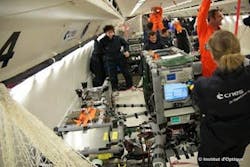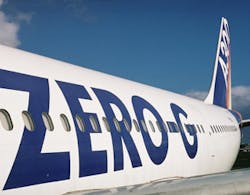Solid-state laser manufacturer Quantel Laser (Paris, France and Bozeman, MT) announced that its EYLSA Fiber Laser completed a series of atom-cooling experiments on board the CNES (French national space agency) Zero-G aircraft. The standard commercial 1W, 780 nm laser source was used as part of an atom-cooling experiment conducted by the laboratoire LP2N in Bordeaux, France and by CNES in order to prove the suitability and the reliability of the laser source for onboard applications.
RELATED ARTICLE: Innovative atom trap catches highly magnetic atoms
Ever since Chu, Cohen-Tannoudji, and Phillips were awarded the Nobel Prize for their development of methods to cool and trap atoms with laser light, the field has expanded rapidly, with researchers using the technique to study fundamental quantum effects that can only be observed very close to 0 K temperature. Quantel says the field has increased dramatically but has been limited by the complexity of the experimental setup and the associated lab-grade lasers and optical assemblies. The Quantel EYLSA Fiber Laser, built in a master oscillator power fiber amplifier (MOPFA) architecture, replaces the mechanically tuned, external-cavity diode laser (ECDL) and tapered amplifier typical for such experiments.
Quantel says its fiber laser is robust, plug-and-play, and based on proven telecom-grade components with much longer lifetime and more rugged reliability than existing ECDL-based systems that allow researchers to spend their time on the results of their atom-cooling experiments rather than on maintaining the alignment and performance of the laser source."For our experiment, we needed to operate in 0G. CNES' Zero-G A-300 offers us this unique opportunity, but puts tremendous demands on the equipment as the aircraft cycles from zero gravity to hyper gravity again and again during a run," said Philippe Bouyer, director of the LP2N laboratory.
"Cold atom experiments have become more and more complicated and researchers do not want to waste time building or tweaking their laser source," said David Pureur, general manager of Quantel’s fiber laser division. "Obviously, not all our customers need to operate in such harsh environments, however, they certainly are seeking to simplify their atom cooling experiments. The EYLSA [trade mark] allows them to spend their time on the experiment, not on the laser source."
EYLSA has 1 W power from a single-mode polarization-maintaining fiber with M squared <1.1, available wavelengths of 780, 767, and 530 to 560 nm, 19” rack mount package, plug-in to full power in < 15 minutes, no maintenance, and two years warranty. In addition to the EYLSA Fiber Laser, Quantel Laser also offers high power, pulsed nanosecond lasers, laser diode stacks, and custom laser solutions.
SOURCE: Quantel Laser; http://www.quantel-laser.com/news-article-106/items/quantels-fiber-laser.html


